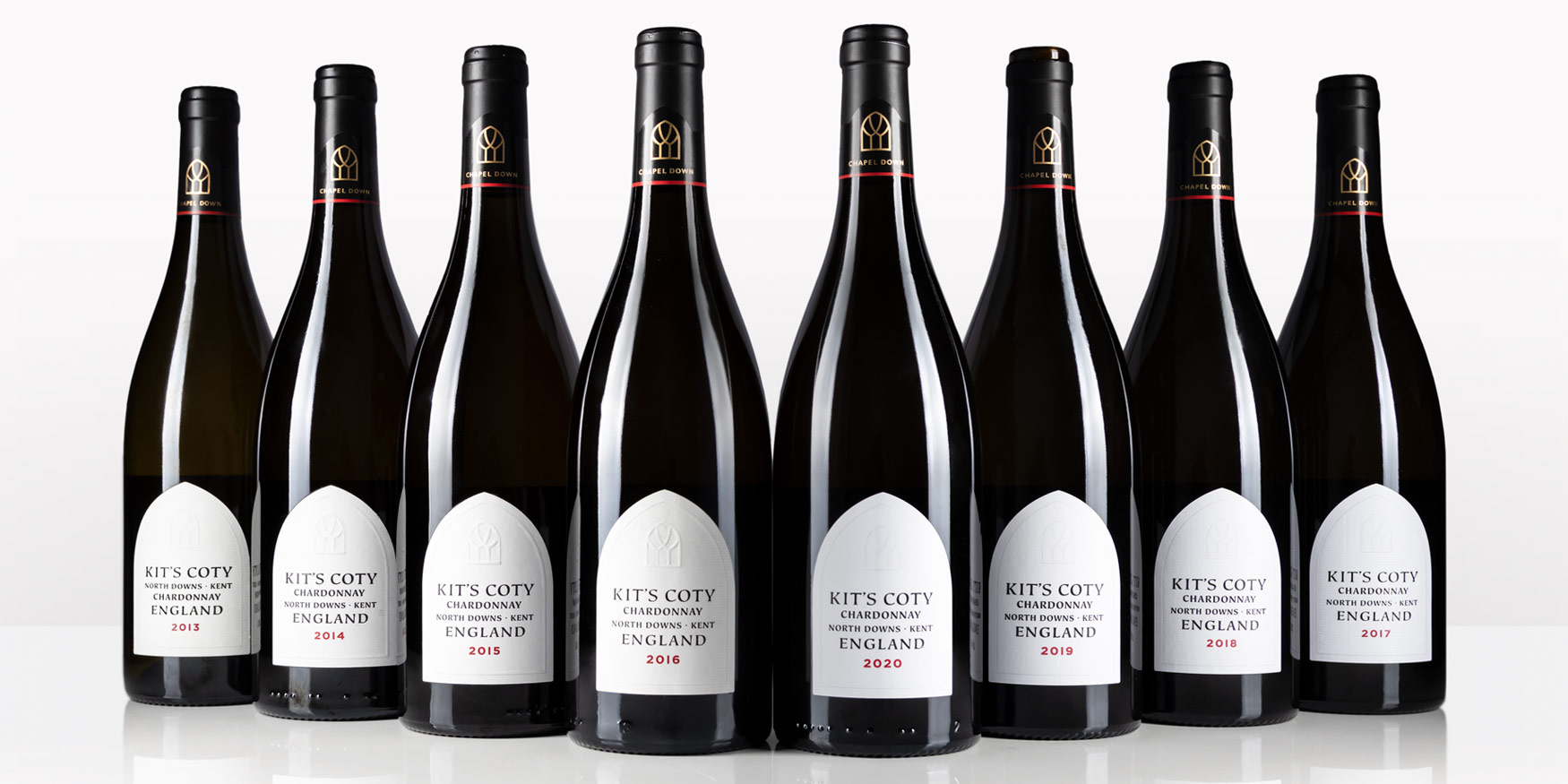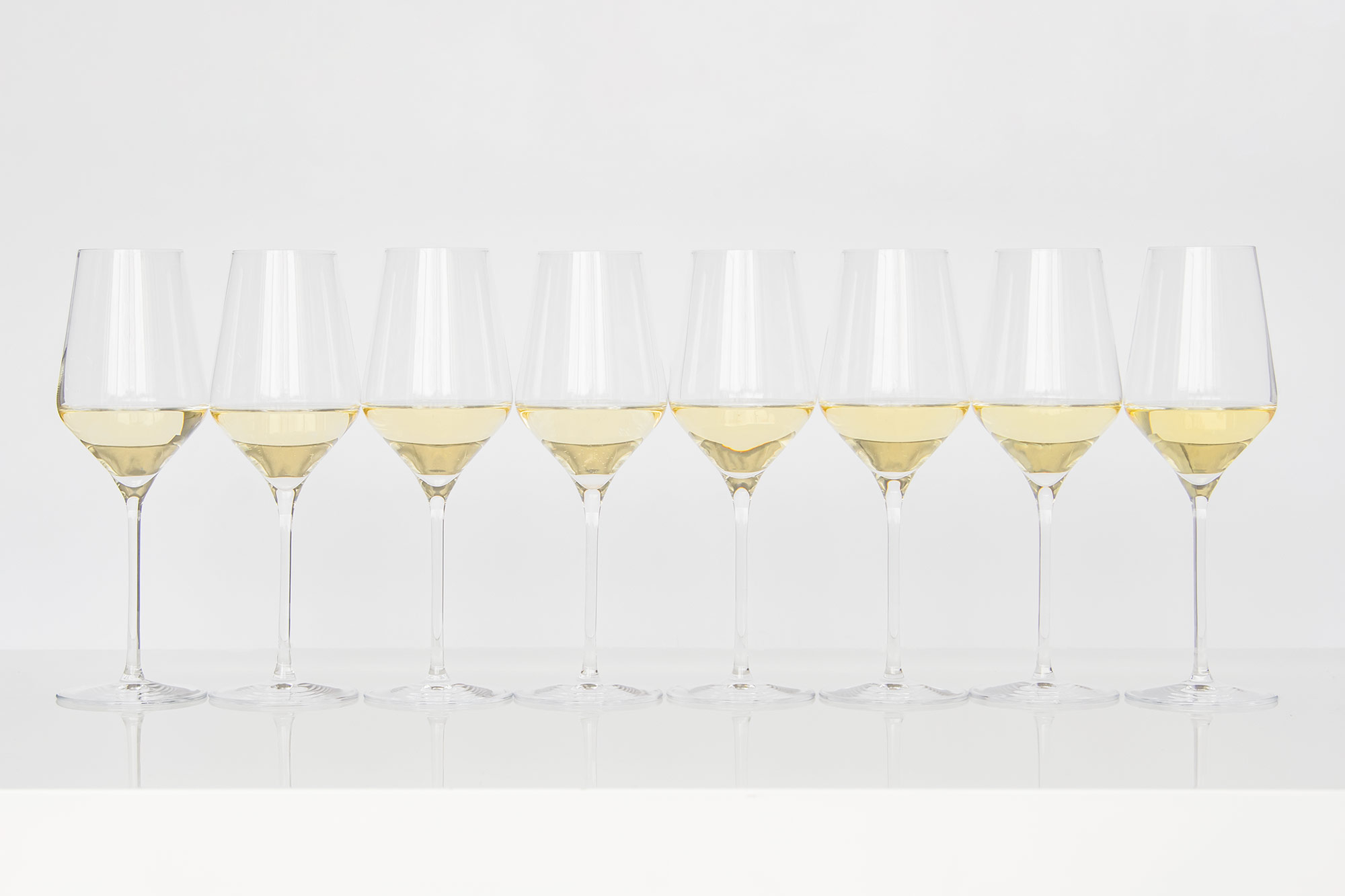
It’s hard to believe that nearly six years have passed since Chapel Down officially launched their Kit’s Coty range of wines. April 2017 saw the official launch of the Kit’s Coty premium sub-brand, although the previous year had seen glowing reviews for the preview of the Kit’s Coty Chardonnay 2013 vintage under its clean, elegant branding. I’m often asked how does English Wine, particularly the stills, age?
English still wine is ultimately an unknown entity as far as ageing is concerned, and Chardonnay, in particular, can be quite a volatile entity in this regard, even worldwide. What better way to find out than the latest in our English Vertical Series? I sat down with four fellow English Wine lovers to taste through all Kit’s Coty Chardonnay vintages from 2013 to the recently released 2020. Note that there was also a vintage in 2012, but this was under the main Chapel Down branding and now rarer than hen’s teeth.
When I first encountered Kit’s Coty Chardonnay 2012 at the then-named English Wine Producers tasting in May 2015, I described it as ‘perhaps the most grown-up still English wine on the market right now’. Each subsequent vintage has improved upon this promising concept.
So what makes Kit’s Coty Vineyard so special? Building on the foundations of great terroir, lime-rich chalk soil, the south-facing North Downs slopes and a unique microclimate, the wines are made with meticulously selected grapes from yield-restricted vines to ensure quality, concentration and character. But, of course, winemaker Josh Donaghay-Spire’s work in the winery must not be overlooked, either.
Whilst the formula for Kit’s Coty hasn’t differed too much from its inauguration, Josh explained to me that improvements in the vineyard include dramatically reduced herbicide use at KC, intending to ultimately eliminate it entirely, as well as a move from double to single guyot pruning. In addition, in the winery, 100% indigenous (wild) fermentation began with the 2013 vintage, as well as the integration of new Burgundy barrels that are seasoned and used over a longer period of time to ensure consistency.
What was fascinating about this particular tasting of all eight ‘official’ vintages of Kit’s Coty Chardonnay was the the impact of bottle age in tandem with vintage variation. The scoring of all five of us was relatively consistent across the board. Vintages 2020 and 2014, both warm and bountiful, reigned supreme and took the top spot, followed by the equally impressive 2018 and 2016 vintages. 2015 and 2017 still showed some consistent qualities, but the signs of colder and leaner years stood out, whilst the 2019, one of the most challenging years in recent times for still wine in England consistently ranked last amongst the tasters. The 2013 vintage was an interesting one. Feeling quite tired when tasted alongside the other vintages, I found it more endearing when I revisited it in isolation on the second day.
Ultimately, we all concluded that for any significant longevity to be found in English still wines, you need to start with a strong vintage in the first place. Quite handily, from 2014 onwards, England has flip-flopped between rich, ripe years and leaner, greener years – the even vintages are the ones to go for here, and I expect 2021 and 2022 may follow a similar pattern.
The technical stats and overall scoring from five tasters (each scoring the wines out of 10) can be found in the table below, followed by my own full tasting notes for each vintage.
Kit’s Coty Chardonnay 2020
The 2020 has a fresh, floral nose of ripe apple and white peach with strong mineral suggestions.
To taste, there is lovely bright acidity, with pronounced citrus and crunchy green apple that softens to white peach. This vintage has a fine crystalline structure that forms a Chablis-like elegance, while lingering minerality and hints of spice maintain a long presence on the finish.
Harvest Date: 30/9/20
ABV: 12.5%
Residual Sugar: 1g/l
TA: 6.6g/l
Kit’s Coty Chardonnay 2019
The 2019 has a greener nose, with hintd of tinned peach, unripe tropical fruit and plenty of citrus.
Unfortunately, the palate on the 2019 falls short of what we have come to expect from Kit’s Coty. This was a challenging vintage across most of England which shows in this wine’s comparative astringency. Again, there are green fruit flavours, rather than ripe apple, and bracing acidity that doesn’t soften like all the other vintages.
Harvest Date: 10/10/2019
ABV: 12.5%
Residual Sugar: 1.9g/l
TA: 6.5g/l
Kit’s Coty Chardonnay 2018
The 2018 has really rich vibrant stone fruit aromas, with hints of mango and pineapple showing the vintage’s ripeness.
To taste, there is ripe, opulent stone fruit with buttery apple and a hint of vanilla toffee. Again, this year’s ripeness is in evidence but this still has a fresh backbone of acidity, and the minerality and spice that Kit’s is known for. This was my second favourite wine of the night, just behind 2014.
Harvest Date: 4/10/2018
ABV: 13.5%
Residual Sugar: 2.9g/l
TA: 6.5g/l
Kit’s Coty Chardonnay 2017
Similar to the 2019, this vintage edges more towards aromas of green fruit, with apple, white peach and a slightly creamy note. A slight hint of bruised fruit blew off with a little time in the glass.
On the palate, this vintage comes into its element after a bit of air, with a focus on peach and green apple flavours, and an underlying freshness. This is clearly a cooler vintage, but with enough ripeness in the fruit to provide comfort, and that signature fresh citrus and minerality at its core.
Harvest Date: 26/9/2017
ABV: 12.5%
Residual Sugar: 1.2g/l
TA: 6.7g/l
Kit’s Coty Chardonnay 2016
On the nose the 2016 retains a lovely freshness, with very clean, ripe orchard fruit, hints of white flower and minerality.
This is elegant, with lots of zippy, fresh and fragrant orchard fruit, white peach and racy citrus. Stylistically, this is the most similar to the recent 2020, but with the benefit of another four years in the bottle.
Harvest Date: 14/10/2016
ABV: 12.5%
Residual Sugar: 3.1g/l
TA: 7g/l
Kit’s Coty Chardonnay 2015
Initially, the 2015 has a slightly funky nose, almost smoky, with greener fruit of apple, preserved lime and greengage.
The palate stands up better than the nose, with slightly unripe stone fruit notes, but also evolved apple and an unusual hint of rhubarb. This is a curious wine with some diverse notes, and while it feels a little on the tired side, it does still hold some interesting textures.
Harvest Date: 20/10/2015
ABV: 12.0%
Residual Sugar: 1.8g/l
TA: 7.4g/l
Kit’s Coty Chardonnay 2014
This vintage shows both its maturity and ripeness, with buttery, indulgent crème brûlée, ripe orchard fruit, and candied lemon.
The palate on this is divine and was one of the highlights of the night, showing just how well English Chardonnay can age. The creaminess is there, with baked apple and pear, buttery, creamy vanilla notes, and an underpinning acidity and citrus freshness.
Harvest Date: 3/10/2014
ABV: 12.0%
Residual Sugar: 3.3g/l
TA: 6.8g/l
Kit’s Coty Chardonnay 2013
This was the funkiest of all the wines, unsurprisingly, given it was the oldest, from a coolish vintage, and actually the first ‘official’ vintage of Kit’s Coty under the sub-label branding. On the nose there are aromas of bruised fruit, preserved citrus and cream cheese.
Interestingly, again, the slightly off notes on the wine blew off with some air. While it felt a little tired and closed on the night, with the fruit feeling muted and overly mature, the acidity remained present. This came alive a day after opening, with mature peach and apricot as well as greengage flavours, and that acidity that feels like it will live on forever.
Harvest Date: 24/10/2013
ABV: 12.5%
Residual Sugar: 2.7g/l
TA: 7.3g/l





Pingback: ≫ Coty Chardonnay de Chapel Down Kit